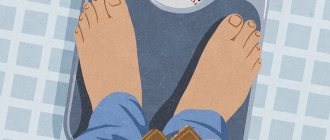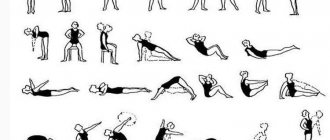Classification of the disease
According to clinical manifestations, childhood anorexia is divided into several types:
- dysthmic - the child cries, is dissatisfied with the process of eating food, is capricious while eating;
- regurgitation - manifested by regurgitation without the presence of other diseases or problems with the gastrointestinal tract during meals or after a heavy lunch;
- active refusal of food - the child may close his mouth, turn away, not swallow, and demonstrate in every possible way his reluctance to eat;
- passive refusal to eat - symptoms include aversion to foods familiar to age.
But it should be remembered that the cause of poor appetite can be not only serious health problems, but also temporary refusal of food during stress, severe overexcitation, illness, or taking certain medications.
What is anorexia
Anorexia is a serious pathology that is characterized by deliberate refusal to eat, which leads to significant loss of body weight. Most often, the pathology is observed in women, less often in men and children.
Female anorexia is associated with a manic desire to be like celebrities and dissatisfaction with one's appearance. Anorexia in men, as a rule, manifests itself as a concomitant condition with the underlying disease.
Childhood eating disorders are most often a symptom of infantility and neurosis. It is worth noting that anorexia nervosa in children under 9-10 years of age is absolutely not similar to a similar illness that is observed in adolescents striving for a slim figure.
Symptoms of anorexia in children
Newborns
The symptoms of infantile anorexia are difficult to miss. The baby may protest against eating. At this age, this is manifested by a refusal to put the pacifier in the mouth, suck or swallow. He turns his head away, spits out food, or simply does not swallow.
Another worrying factor is frequent vomiting. Especially after eating a large amount of food. It usually occurs almost immediately after feeding. In addition, children often cry and whine when it comes to eating.
With such manifestations, it is important to exclude the presence of intestinal infections and other health problems. If pathologies are excluded, then without treatment such behavior can become entrenched and lead to severe weight loss and other consequences of the disease.
Toddlers (1-3 years old)
At this age, a child may experience temporary problems with appetite when new foods appear in the diet. Food aversion manifests itself in passive and active ways. In the first case, the symptoms will be the inability to feed adult food - the child’s diet usually does not include meat, vegetables, cereals and other familiar dishes, regardless of the method of preparation.
Active resistance means fighting, pressing lips tightly, spitting out food. The child can also play with food, turn over plates, throw away spoons and forks. If no health problems are found, then treatment for an eating disorder is required.
Preschool age
In children aged 4-7 years, parents may notice the following symptoms:
- direct refusal of food without complaints about health;
- worsening sleep – problems falling asleep, insomnia;
- too much excitability or lethargy;
- isolation in communication with peers - often takes on signs of autism;
- frequent constipation;
- skin itching;
- incontinence.
When communicating with sick children, you should not count on a frank conversation about problems. Despite their young age, children can hide the problem.
It is important to monitor the child’s weight; if it is rapidly decreasing, then this is a 100% factor for consultation with a specialist.
Severe anorexia is much more difficult to deal with, because in addition to psychological problems, you need to literally save lives, as well as minimize negative health consequences.
School age
Diagnosis and treatment of anorexia at the age of 7-10 years becomes much more difficult, because children begin to hide their experiences better. During this period, it is unlikely that the child will decide to throw the plate off the table or start crying loudly.
The manifestation of symptoms begins with frequent avoidance of meals for various reasons. This could be playing sports, studying, or talking with friends. Joint lunches and dinners will become rare, because in the presence of parents it is difficult to throw food in the trash or flush it down the toilet. Girls may become interested in fashion and become interested in famous actresses, ask or search online for information about diets.
You should know that if all of the above symptoms are present, even in the absence of serious weight loss, full treatment is necessary.
To begin treatment, it is necessary to involve a child psychiatrist and other specialists who are familiar with the course of the disease in children. Complicating matters is that parents rarely realize the extent of the problem in time. Therefore, the first visit to a specialist usually occurs two to three years after the onset of symptoms.
How to understand that a child has anorexia (or bulimia). And what to do with it
Anorexia and bulimia are two eternal fears of parents of teenage girls. Moreover, the age of those “sick” is getting much younger. Natalya Fomicheva, a specialist in psychotherapy for psychosomatic disorders and eating disorders, spoke about
Useful Mela newsletter twice a week: Tuesday and Friday
SUBSCRIBE
What is the main health problem among teenagers today: obesity or anorexia?
Due to their mental characteristics, adolescents are sensitive to all types of eating disorders. A person grows, his body and its perception change, he experiences constant pressure. During adolescence, the three main problems are anorexia nervosa, bulimia nervosa and binge eating.
In general, anorexia nervosa is not very common and is not an epidemic or global problem. But, as a rule, if a teenager gets sick, it is difficult for him to get psychological help - we have not yet fully developed a support system for such children. This disease is truly dangerous: it leads to severe health problems, including death. Girls (and mostly girls get this disease) can die from exhaustion or additional diseases.
Overeating may or may not lead to obesity. Of course, there is more of it simply because to develop anorexia it is not enough to want to lose weight, you also need to have a certain genetic predisposition. Not everyone who goes on a diet turns out to be such “lucky” people. In addition, some of them develop into bulimia.
So does everything happen differently all over the world or in Russia?
In Russia the view on this problem is very different. We still have people, especially those not associated with psychology, who believe that this is some kind of whim, that this is a story about how you need to pull yourself together and start eating. Or pull yourself together and stop eating. But a person cannot cope with this on his own, in the West they already understand this. There is a therapeutic treatment protocol for adolescents and adults who suffer from eating disorders, entire centers that systematically help in all areas.
We still have certain problems with diagnostics and with the way treatment is structured. In Moscow you can still find institutions where teenagers can be helped with anorexia nervosa. In the regions this is very difficult. Parents and teenagers are left alone with this story.
Is the modern trend towards body positivity changing the situation? In general, how strong is the influence of the external context and society?
Let's start with the fact that anorexia is not a new disease. At the everyday level, it is generally accepted that “everyone on TV began to lose weight,” after which the epidemic began. Cases of anorexia nervosa were recorded both in the Middle Ages and in the 18th–19th centuries, that is, this is not a modern problem.
Previously, anorexia nervosa took the form of asceticism and was, for example, religiously colored, but now it is a story about the fact that thinness equals social success.
To be loved, accepted and liked on Instagram, you need to be thin
Let's put it this way: body positivity reduces the likelihood of dietary behavior. It can provoke breakdowns in both directions: someone can go into anorexia, someone into bulimia, someone into overeating. If a person lives in a society where they are relaxed about the body and are not forced to look conventional, the likelihood of developing a disease is less.
Although this will not help with a strong genetic predisposition. A person really sees himself as fatter than he really is.
Previously, there was a lot of talk about different groups on social networks where teenagers lose weight together. How common and dangerous is this?
These publics make the situation worse. Girls don't just egg each other on, there are a lot of toxic interventions there. For example, self-harm often occurs with anorexia: teenagers cut themselves, burn themselves, they can write “fat” on their thigh with a razor, and then post photos in groups. They also share diets and supervise each other.
If we’re going to talk about some kind of protection for teenagers from the Internet, then I would start with these public pages. Because, unfortunately, we have a high mortality rate from anorexia. There are few statistics for Russia, but I can say that of those who become ill, about 20-25% die.
This always surprised me. After all, a parent cannot help but notice that your child is losing weight before his eyes. How can this be?
Firstly, in the first stages, losing weight is considered a positive thing. “You’ve lost weight” means “you look good.” If a teenager, for example, who is overweight from the point of view of his parents, suddenly “takes charge of himself” and begins to lose weight, this is usually encouraged.
When a child crosses a certain line, it is difficult to do anything. Metabolic processes are greatly restructured. For example, visceral fat, which supports internal organs, disappears, and any food, even lettuce, feels incredibly heavy in the body. Patients with anorexia are cunning: they pretend to eat, but they themselves throw it away. They use all sorts of tricks to prevent food from entering the body. Patients usually come to me weighing 27-37 kilograms.
Are we still talking about teenagers or can this also occur in children under 10 years of age?
Anorexia is rapidly making you look younger. Not long ago, Western colleagues discussed anorexia in four-year-olds. There is a certain sexualization of children. Very little girls are dressed like models and given make-up. At the age of 6-7, those who play sports professionally and experience strong pressure from a coach, for example, in gymnastics, get sick more often.
Again, eating disorders in athletes are a separate matter. Great sport is not just about improving physical strength and fitness. Even such a phenomenon as “prepuberty” arose. Twenty years ago it was not recognized in developmental psychology.
Now maturation begins earlier. 5-10 years old is the age when girls already pay a lot of attention to their appearance. I know stories where girls wanted to do hair removal at the age of seven. So if there is a predisposition, then the early debut of nutritional deviations is quite likely.
What causes anorexia, what are the main reasons?
If we are talking about anorexia nervosa, then this is a genetic predisposition. We have a region on chromosome 13 that is responsible for such a paradoxical experience of hunger.
Most of us experience hunger as an uncomfortable state - we want to eat faster. For approximately 10-15% of people, hunger is experienced as euphoria. It gives tone
It is believed that this is an evolutionary thing, which was invented so that when the entire tribe has been sitting hungry for two weeks without a mammoth, some 10% will go hunting and get food.
Combined with personality traits and “disturbed body image,” feelings of imperfection, a toxic environment, and family problems, all this creates a serious risk.
By the way, when the 13th chromosome was discovered, anorexia began to be considered a neuroendocrine disease.
What difference does this make in terms of treatment?
This means that it is not just fantasy or psychic. This is also supported by the brain and body. Therefore, protocols need to be changed. Psychotherapy simply won’t work, so in the West they are developing large-scale support programs, including drug treatment.
How do parents influence this whole story?
If we are talking about dominant parents who are trying to control the child in everything, refusing to eat can become a kind of protest. Nutrition becomes an area that only the teenager controls. Parents, trying to put pressure, aggravate the situation.
The main therapeutic recommendation for parents is not to talk about it at all. Pretend it doesn't exist. Of course, it is difficult to behave this way, but you need to understand that any attempt to feed will provoke an even greater rollback, since we have two laws in eating behavior:
- restriction gives rise to overeating;
- Force feeding gives rise to food refusal.
You can’t talk to a girl about her body, because any phrase from the series “your cheeks are rounder” will give a strong kickback. You need to diligently avoid offers to weigh yourself - this immediately causes stress and strong rejection.
But in general I am against blaming parents. Poor parents are already stressed, and now they are being blamed. No, many factors must come together for a child to develop anorexia or bulimia.
About how it all begins. Could a difficult exam, university admission, or unhappy love be a trigger?
The onset is usually associated with dietary behavior, but this itself is an external story. What's going on inside? Suddenly there is a solution to all problems: if I am thin, I will be happy, they will love me, I will be successful. As soon as this chain converges in the head, the process of losing weight begins.
The main danger of anorexia is that there is no number to reach - losing weight is endless, weight loss becomes an end in itself. Therefore, anything can trigger the situation. The main thing is that the body becomes the culprit of all misfortunes, if you change it, then everything will go fine.
What do you do in therapy with these teenagers? How are eating disorders generally treated?
To be honest, the results of therapy do not always satisfy us. About 30% of patients become bulimic after anorexia. Now Western colleagues are discussing the term “bulimorexia” - an intermediate state. They somehow live in this version: people have a complex relationship with food, but they do not lose weight to critical levels. When they get stressed, I start to freak out. If life is more or less calm, they control themselves.
Only 30% recover, that is, return to normal functioning
For example, we work with body image - with accepting the body as it is. We work with bodily needs, and most importantly psychological ones - with the experience of being useless, lack of love.
In fact, we do not work with eating behavior, because with anorexia it is impossible to force a person to eat. But, unfortunately, we are often limited in time. Therefore, the sooner parents seek help, the more likely they are to help.
Listen to the full interview with Natalya Fomicheva here. The conversation took place on the air of “Radio School” - a project of “Mela” and the radio station “Moscow Speaks” about the problems of education and upbringing. Guests of the studio are teachers, psychologists and other experts. The program is broadcast on Sundays at 16.00 on the radio “Moscow Speaks”.
Photo: Shutterstock (Photographee.eu). Illustrations: Shutterstock (Natalia Hubbert, Maltiase, Viktor Manko, Tina Bits)
Diagnosis of the disease in childhood
Diagnosis of childhood nervous diseases is complicated by denial and silence of the reasons for refusing food. Therefore, if the baby can communicate, then treatment begins with a conversation. Parents are also interviewed to look for behavioral problems, changes in weight and appearance.
The process uses special questionnaires to detect eating disorders. You can conduct tests with your child to determine self-esteem and emotional state. Popular methods SMIL, Dembo-Rubinstein and others.
To treat the disorder, you need to rule out other causes of the problem. Especially if symptoms appear in young children. It is almost impossible to establish full contact with them, so the survey is carried out only with parents, test data and the general clinical picture are taken into account.
Also, treatment of childhood anorexia includes general laboratory tests, including blood and urine tests, hormone tests, and checking the condition of the kidneys and liver. To understand the causes of poor appetite, the gastrointestinal tract is examined using instrumental methods.
A child psychiatrist must exclude the early development of schizophrenia or other serious mental disorders, against the background of which anorexia may develop as one of the symptoms. To do this, the specialist checks thinking functions and other features.
Treatment
Treatment of children for anorexia involves working in two directions: restoring the gastrointestinal tract with subsequent weight gain and instilling a correct and healthy attitude towards food.
In the first case, classical methods of combating the disease are used. This includes eating five to six meals a day and maintaining a sleep schedule. The use of medications to relieve vomiting, diarrhea and constipation is also necessary.
At the second stage, doctors adhere to the following sequence: first - psychotherapy, then treat psychological abnormalities.
As a result, the patient returns to normal mode and is already able to control his emotions.
Main components of treatment:
- Cognitive behavioral therapy. It involves working with a psychotherapist, which lasts at least four months. Includes correction of unhealthy ideas, training in controlling pathological emotions. The doctor helps the patient develop adequate self-esteem, love for himself and his body. The teenager is encouraged to independently choose his own basic diet, which should include those foods that he excluded previously. The child starts a personal diary, where he writes down his thoughts and experiences, trying to transform them in a positive way.
- Family psychotherapy. The clinic holds special sessions where family problems that provoke the development of anorexia in a child are discussed. Parents should be explained what not to say or do in relation to a teenager, so as not to hurt his feelings and not provoke a relapse. Mother and father are obliged to contribute as much as possible to maintaining a positive atmosphere within the family in order to obtain good treatment results.
- Pharmacotherapy. Doctors additionally prescribe medication that will increase the effectiveness of psychotherapy and self-control of the child. As a rule, specialists prescribe antidepressants and appetite stimulants.
Treatment of childhood anorexia
At TsIRPP, you can undergo outpatient and inpatient treatment for childhood anorexia, depending on the patient’s health status at the time of contacting the clinic. We offer:
- an individual approach to solving problems with childhood feeding disorders;
- application of methods of treatment and identification of the causes of the disease that are recognized as effective and safe in the world community;
- a better approach through collaboration with the Linehan Institute, an international academy for eating disorders, where our therapists receive additional training and supervision;
- progressive treatment methods that involve the involvement of relatives;
- drawing up an individual menu taking into account food preferences for each patient;
- treatment services in the intensive care unit if the child is in serious condition;
- participation in family intensives, communication with a psychotherapist via Skype to exclude relapses of childhood anorexia.
Anorexia in adolescents and toddlers is often associated with weight loss, so the first goal of treatment is to address symptoms of malnutrition. At this stage, treatment methods such as frequent fractional and parenteral nutrition and maximum rest in bed are used.
When weight gain is noted, you can begin to address the issue of food perception for children. With the help of a psychologist, psychotherapist or psychiatrist, the fight against the psychological manifestations of anorexia begins. To do this, cognitive behavioral therapy is carried out for up to six months, which allows you to change distorted children's ideas about food and get rid of anger and anxiety.
Family therapy plays an important role in treatment. It is important to find problems in the relationship between parents and child that could provoke the disease.
Classification
Anorexia nervosa in school-age children is divided into several types, which are diagnosed according to the characteristics of the development and course of the disease and the stages of the pathological process.
In medicine, the following syndromes are identified that are associated with the corresponding symptoms of the disease:
- Monothematic dysmorphia (prevalence of fixation on extra pounds).
- Bulimia (spontaneous eating in large quantities, uncontrolled overeating).
- Vomitomania (attempts to get rid of eaten food by inducing vomiting and diarrhea).
There are also three stages of development of somatogenic anorexia in children and adolescents:
- Initial. It lasts from three to four years and begins in preschoolers or primary school students. The main signals about the onset of the disease are a rapid change in interests and changes in the idea of an ideal body and beauty.
- Active. Widespread among teenagers. Characterized by persistent and frequent attempts to reduce weight to an ideal figure. Severe dietary restrictions, grueling workouts lasting several hours, diuretics and laxatives, and the traditional method of inducing a gag reflex are used. A hallmark of the stage is weight loss of more than 30-50% of total body weight.
- Cachectic. The body is exhausted, asthenic syndrome manifests itself, critical thinking is impaired. If medical assistance is not provided in time, the patient will die.










